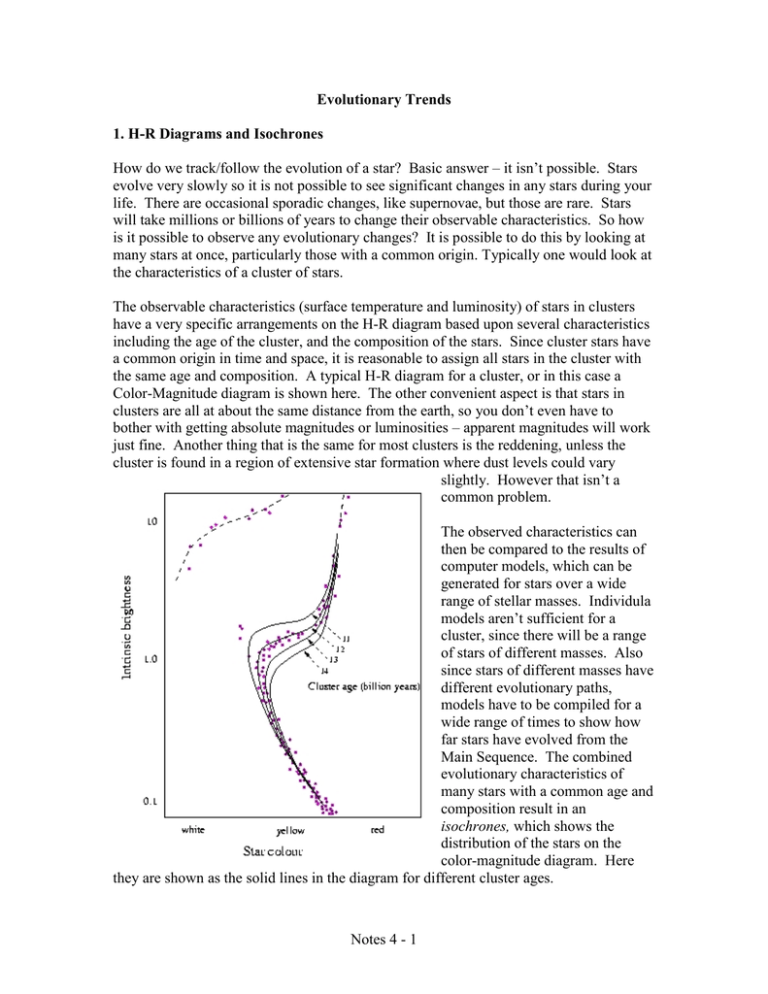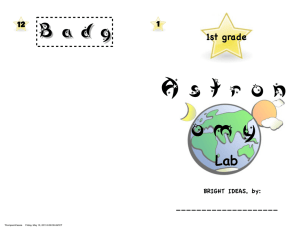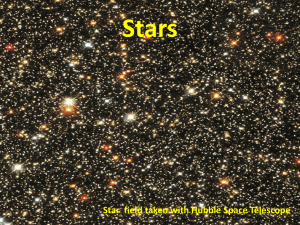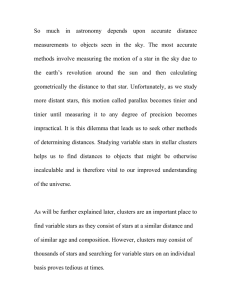How do we track/follow the evolution of a star? ... evolve very slowly so it is not possible to see... Evolutionary Trends
advertisement

Evolutionary Trends 1. H-R Diagrams and Isochrones How do we track/follow the evolution of a star? Basic answer – it isn’t possible. Stars evolve very slowly so it is not possible to see significant changes in any stars during your life. There are occasional sporadic changes, like supernovae, but those are rare. Stars will take millions or billions of years to change their observable characteristics. So how is it possible to observe any evolutionary changes? It is possible to do this by looking at many stars at once, particularly those with a common origin. Typically one would look at the characteristics of a cluster of stars. The observable characteristics (surface temperature and luminosity) of stars in clusters have a very specific arrangements on the H-R diagram based upon several characteristics including the age of the cluster, and the composition of the stars. Since cluster stars have a common origin in time and space, it is reasonable to assign all stars in the cluster with the same age and composition. A typical H-R diagram for a cluster, or in this case a Color-Magnitude diagram is shown here. The other convenient aspect is that stars in clusters are all at about the same distance from the earth, so you don’t even have to bother with getting absolute magnitudes or luminosities – apparent magnitudes will work just fine. Another thing that is the same for most clusters is the reddening, unless the cluster is found in a region of extensive star formation where dust levels could vary slightly. However that isn’t a common problem. The observed characteristics can then be compared to the results of computer models, which can be generated for stars over a wide range of stellar masses. Individula models aren’t sufficient for a cluster, since there will be a range of stars of different masses. Also since stars of different masses have different evolutionary paths, models have to be compiled for a wide range of times to show how far stars have evolved from the Main Sequence. The combined evolutionary characteristics of many stars with a common age and composition result in an isochrones, which shows the distribution of the stars on the color-magnitude diagram. Here they are shown as the solid lines in the diagram for different cluster ages. Notes 4 - 1 To make things a bit more complicated, astronomers may not know the composition of the stars in the cluster, or they may want to study many different clusters, so isochrones are usually constructed for quite a few different metallicities as well as ages. The generated isochrones can then be matched to the observed distribution of stars in an H-R (or Color-Magnitude) diagram to try and match ages and metallicities. Since there is still controversy about various aspects of the computer models that go into these results, not all authors will have the same isochrones or evolutionary tracks even for the same ages and compositions. Models are continually being revised and updated to account for effects such as convection, rotation, mass loss, etc., that are not always easy to model. And of course when you are comparing isochrones to observational data, there is the influence that dust has on the color, and magnitudes of the observed stars, so corrections are needed for those effects as well. In a few cases it is possible to compare stellar models to individual stars. This may be possible for stars in binary systems where stellar mass data is available or for other stars where distance and luminosity information can be determined. So whether it is using observations of clusters to double check the quality of the stellar models or individual stars, we can now surmise what might be going on inside of stars (what is buried below the surface) based upon the results of the computer models. 2. Stellar Cores – Pressure-Density How do the cores of stars change as they evolve? The best way to characterize the changes in the core is by tracking the changes in the temperature (T), density ( ), and composition (X,Y,Z) . Actually composition is the least important of these, since most other stellar characteristics have a much stronger dependence on T and . In order to follow the values for Tcore and core we’ll use a graph of the temperature and density. Actually this plot uses the log values since the values for temperature and density can be quite varied when you look at all of the different stars out there. The Log (Tcore) –Log ( core) diagram shown below also indicates transitions between areas where various equations of state dominate, and these typically just depend only on the values of Log (Tcore) –Log ( core). The temperature and density both increase in the normal sense (to the right and upwards in the graph). Notes 4 - 2 While most of the boundaries are pretty well defined, the boundary between ideal and radiation pressure is not really correct. Radiation pressure and gas pressure can exist together, not as an option – so there isn’t a point where one replaces the other. Typically only when radiation pressure becomes very overwhelming is it possible to ignore the contribution of gas pressure. So the boundary marked on the graph is the location where Prad=10 Pgas. The other boundaries are found by equating the pressure relationships and solving the formulae so that they are only functions of density and temperature. So those boundaries mark locations where the dominant form of the gas transitions from one form to another. In reality you will not have exactly everything being in one form, there will tend to be some material that is in a slightly different form – but the most likely form can be found using the diagram. The core of the Sun on this graph would be found in the ideal gas realm, as would all Main Sequence stars. This means the ideal gas law dominates in the core – it may not be the only thing happening there but it is the most important. Another useful thing to check out is where the various fusion processes occur since fusion is a function of density and temperature – here is a map showing where those events occur. The lines shown indicate the lowest possible values for the reactions to occur. You notice that there isn’t much fusion extending into the regions of degenerate material. This is because such material is not very stable, and any reactions that do happen are pretty short lived. The iron photodisintegration is the break down of iron down to helium Notes 4 - 3 due to extreme temperatures. The strip shown here is where there would be an equal number of iron and helium nuclei present, indicating an equilibrium location for the process. Stars in various phases of evolution and fusion would lie above and/or to the right of the various thresholds that are shown here. No fusion occurs in the lower left corner. Logically you would expect stars on the density-temperature graph to move towards the upper right corner as they evolve, and the various fusion cycles would continue over time. But how do stars really evolve? While we could find out using a super computer, we’ll instead use the polytropic models. You have a relationship from polytropic models for pressure Pc (4 )1/ 3 BnGM 2 / 3 4/3 c 3-9 And the ideal gas law T Pgas 2-9 These can be combined to get a relationship between , T, M in the form c Tc3 M2 Or taking the log of both sides you get Log( c ) 3Log(Tc ) 2Log(M ) 4-1 When you graph this on the temperature density plot, you end up with a straight line from lower left to upper right for individual stars. This indicates that stars tend to stay within the domain of the ideal gas law even as their core density and temperature increase as they evolve. We do know that stars do get into the other regions of the graph over time, particularly at later phases of their evolution – typically a star’s core would become degenerate over time. Equation 4-1 shows that the distribution of stars in the ideal gas domain is according to mass – they are spaced out uniformly. However, once a star gets a degenerate core, the density doesn’t depend on temperature anymore – it is only a function of the mass. Notes 4 - 4 The evolution line then becomes horizontal. In this area c M2 The paths shown in the degenerate areas can only go so high (in terms of mass) since the Chandrasekhar limit will set the upper limit to the values that will be attained for the mass. So theoretically a high mass star goes straight and a low mass star gets curved over into the degenerate regions as they evolve. The temperature-density plot shows us some limits for masses such as 1. There is a lower limit for fusion to occur 2. Highest mass possible for a stable star. Any higher, and radiation pressure would destroy it. This ends up being more than 100 solar mass 3. Different stars will reach different fusion stages depending upon their masses Do stars actually follow the paths described by polytropes in the Log (Tcore) –Log ( core) graph? Of course not! There are all sorts of things that can alter the evolution of a star – 1. Mass loss 2. Much more complex equations of state (not just ideal gas) 3. Different fusion processes may occur at the same time, or there may be starting and stopping of fusion which makes the paths much more complex. 4. Eruptive events like helium flashes In spite of the limitations, the temperature-density graph can illustrate the changes in the core of a star over its life. Here is the typical life of such a star – First there is the formation of the star, which would actually be somewhere off the graph in the lower left corner. This phase would have the temperatures, pressures and densities at very low levels. As the star contracts, its central temperature and density would gradually increase up along the lines indicating constant mass on the graph until it reaches a fusion threshold. The first one is hydrogen fusion, and depending on the stars mass, it would either make use of the P-P cycle or the CNO cycle as the dominant Main Sequence fusion process. The star then sort of stays in that location on the graph for a while……. Of course if the mass isn’t big enough to reach the hydrogen fusion limit, it would just keep contracting slowly while it keeps on cooling. This would be a failed star. Typically this is the fate for stars with masses less than approximately 0.1 M. When hydrogen runs out, the core will contract and become hotter and denser (so it would move up and right). The star keeps going in this direction until it gets to the next fusion stage (helium fusion). If it doesn’t get up to that threshold, it may turn over Notes 4 - 5 towards the degenerate area. Once helium fusion does start, it will again pause on the graph for a long time and keep fusing along happily. Carbon fusion would start at a point close to the boundary between the degeneracy limit and the ideal gas law. Theoretically this should result in a fusion event that would be rather catastrophic – carbon detonation. The odds of this actually happening are extremely unlikely since a star would have to maintain a constant mass during its entire life, and it must have a very precise mass (exactly equal to the Chandrasekhar mass). So carbon ignition isn’t always to dramatic. Depending on the stars mass the successive fusion processes will start up. However there is a point where fusion does hit a wall – that of iron fusion (photodisintegration). This would result in a major release of energy that will basically end the star’s life. So you actually could have several options – though not all are realistic or likely. 3. H-R Diagram Relations There are some fun relations that we can derive for stellar structures which allow us to approximate their physical characteristics on the Main Sequence. For example we have the following Conservation of Mass formula dm 4 r2 dr 2-1 Thermal Equilibrium dF dr 4 r2 q 2-2 Hydrostatic Equilibrium dP dr GM r2 2-3 Radiative Transfer dT dr 3 F 4acT 3 4 r 2 2-17 Energy Production q q0 T n 2-18 And the ideal gas law (for stars on the Main Sequence) Pgas T 2-9 Notes 4 - 6 Let’s re-arrange things by switching the values from dr to dm. That isn’t such a big thing and basically involves substituting equation 2-1 into the others to get the following (in terms of dm) dr 1 dm 4 r 2 dF q0 T n dm dP Gm dm 4 r4 dT 3 F 3 dM 4ac T 4 r 2 2 Let’s make this easy by getting rid of the differential term (those “d” parts of the above formulae). There are various ways to do this, such as using dimensionless substitutions, and redefining the variables, but the end result is the same – simplified formulae. You end up with the following relations – P T F F GM 2 R4 M R3 P 4-2 4-3 4-4 ac T 4 R 4 M q0 T n M 4-5 4-6 Okay, what can we learn from this? If you combine 4-2, 4-3, and 4-4, and solve for T you get a relation for T in terms of M and R. This can then be put into 4-5 to get F M3 4-7 Or put more simply, on the Main Sequence, mass is related to flux (luminosity) by this power law – which is sort of what we observe (go back to the first set of notes). Eddington’s Standard Model also gives this same relationship, but this method just provides us another way of seeing physical reality in some approximations of complex formulae. Notes 4 - 7 We can also combine 4-2, 4-3, 4-4, 4-6 and 4-7 to get a relation between radius and mass for various values of n (which is the power value for the temperature in the fusion relation) R M n 1 n 3 4-8 What are the relations for different values of n? For CNO cycles, n=16, so the radius is almost proportional to the mass (mass raised to a value that is nearly equal to 1). For n=4 (the value of the PP reaction) we have radius related to mass to the 3/7 power, so that the radius will increase with increasing mass. This is the case for a non-degenerate material. One more check on reality. We have a basic relation between L, T, R (equation 1-4). Let’s use some of the new relations and see how that ends up on the HR diagram. Use equations 4-7 and 4-8 to get rid of the radius in equation 1-4. This will result in the following ugly beast – 1 L 2( n 1) 3( n 3) Teff4 4-9 And for Main Sequence using the PP reaction, we have n=4, so L0.71 Teff4 L Teff5.6 Log( L) 5.6Log(T ) c And for those using the CNO reaction we have n=16, and you get Log(L) 8.4Log(T ) c Do we see this sort of relationship between surface temperature and luminosity on the Main Sequence? Yes we do – there is a curve or bend in the shape of the Main Sequence (actually quite a bit of a curve, but the above relationships follow it fairly well.) Notes 4 - 8 And if you combine 4-2, 4-3 and 4-4, you get the relationship that shows how temperature varies as M/R. This can be combined with 4-8 to give a relationship that indicates that temperature varies as M4/(n+3). With n=4 (PP reaction), that gives us temperature varying with M4/7 We know that stars have to reach a certain temperature for fusion to occur (about 4 million K), so this relation can tell us the minimum mass needed for fusion to occur. Just scale the mass and temperature to the Sun’s central temperature and mass to get Tcore Tcore, sun M M sun 4 7 For Tcore = 15 million K, this gives a minimum mass needed for hydrogen fusion being 0.1 M. And using 4-7 this gives a minimum luminosity of 0.001 L. We’ve basically determined the bottom of the Main Sequence in terms of mass and luminosity. Log Rho Now all of this discussion has made use of some major simplifications, such as ideal gas laws, polytropic models, constancy of physical parameters, etc. How do the really complex stellar models (the ones with all of the bells and whistles) behave in the temperature-density plot? Below is a sample of some models showing the evolution from the Main Sequence, through the various fusion stages and finally to the end when the core stops fusing and 8 becomes degenerate. The 7 lines are ordered according to the 6 masses of the stars, but they clearly don’t 5 follow the same path that is 4 defined by assuming that 3 the ideal gas law is appropriate inside of all 2 stars, or the path that is found by 1 using a polytropic 0 model….but 7 7.2 7.4 7.6 7.8 8 8.2 8.4 8.6 8.8 9 that’s the way it Log T works. Notes 4 - 9 Overall the paths predicted by the various assumptions and simplifications aren’t close to the complex paths, but they do show the various trends that are expected. So you shouldn’t complain….. Notes 4 - 10







